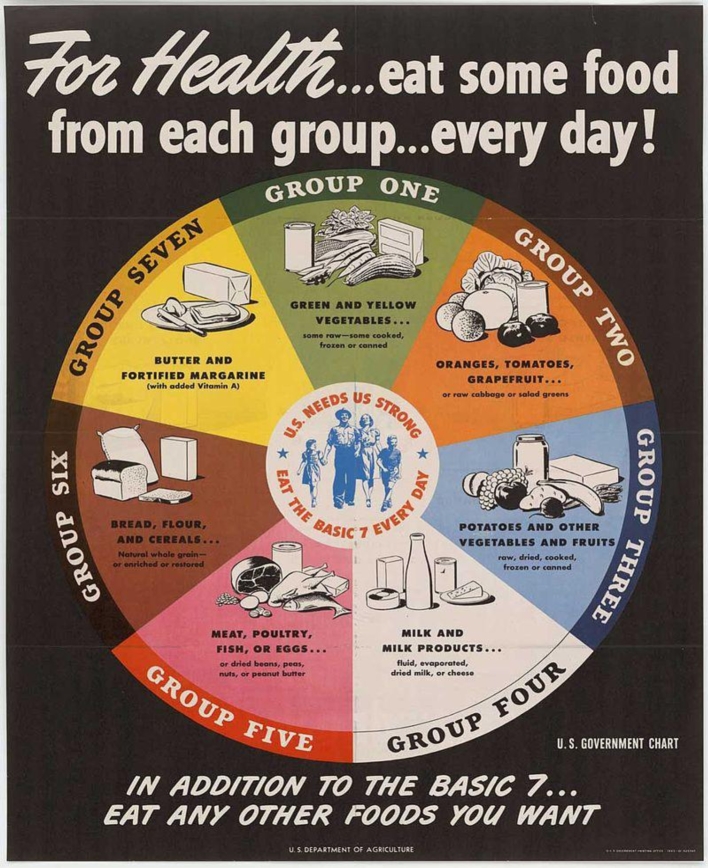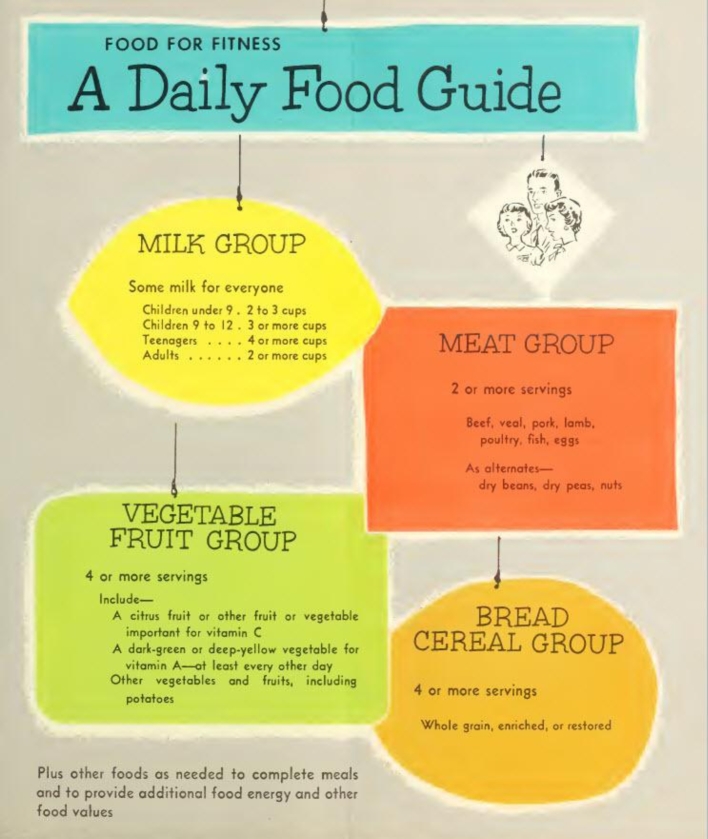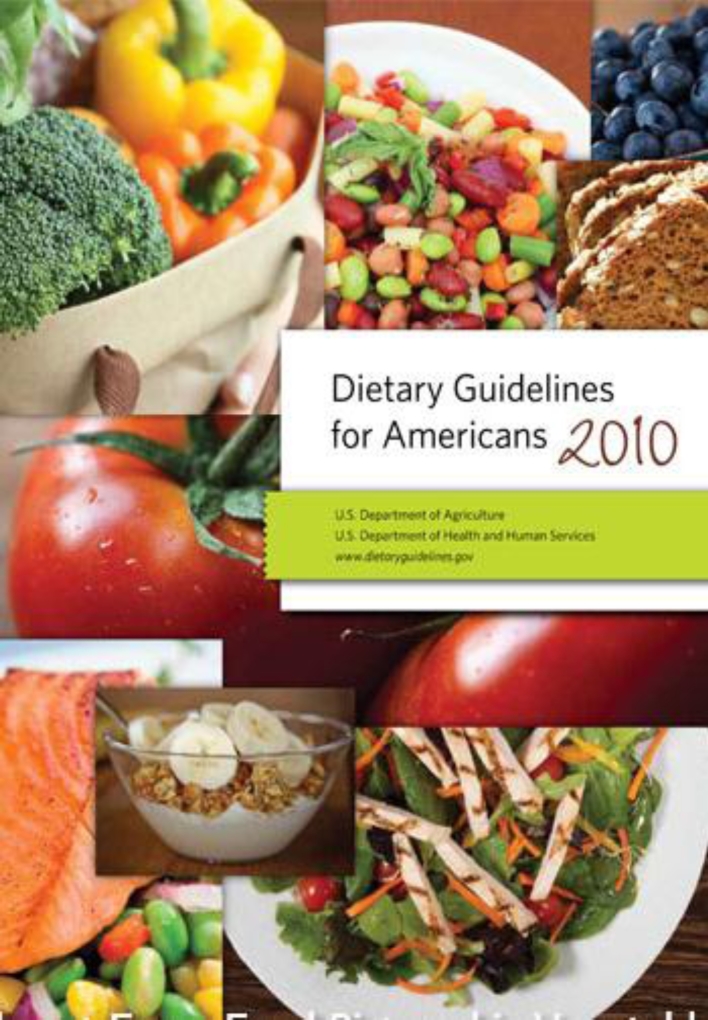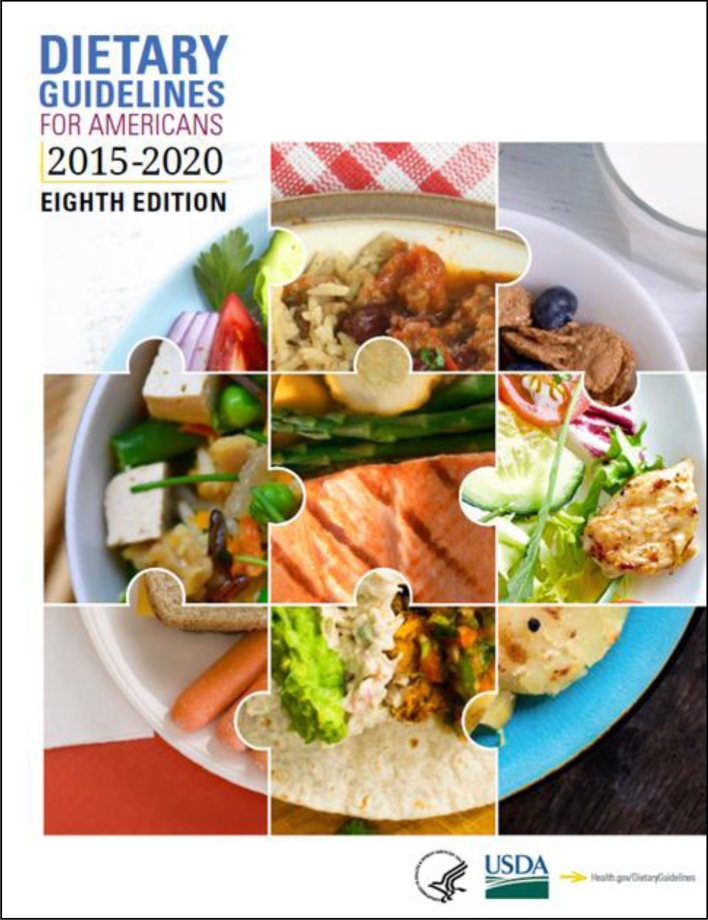Abstract
Evidence-based dietary guidance in the United States has progressed substantially since its inception >100 y ago. This review describes the historical development and significance of dietary guidance in the United States, including the Dietary Guidelines for Americans (DGAs), and emphasizes the foundations upon which they were developed, the process in the formation of past and current guidelines, and present and future applications. Dietary guidance during the first half of the 20th century was focused primarily on food groups in a healthy diet, food safety, safe food storage, and the role of some minerals and vitamins in the prevention of disease. This was punctuated by World War II messaging to reduce food waste and increase food storage. In 1980, the first DGA report was released, and later, the USDA and the Department of Health and Human Services (HHS) were given a mandate for reissuance and reassessment every 5 y. An ad hoc advisory committee made up of nongovernmental experts was established for each edition to review the scientific evidence and provide content recommendations to the Secretaries of the USDA and the HHS. Wording was changed from negative (avoid) to positive (choose) and emphasis was increasingly placed on reducing the prevalence of overweight and obesity and prevention of chronic diseases. Today, the DGAs guide all federally funded feeding and educational programs, including food policies, food assistance programs, and consumer education programs, as well as these programs at the regional, state, and local levels. Additional users include dietitians and other health professionals, food service personnel, food and beverage manufacturers, schools, and day care facilities. Currently, the DGAs are intended for individuals aged ≥2 y. Future editions of the DGAs will include guidance for infants and children <2 y, as well as pregnant women.
Keywords: Dietary Guidelines for Americans, food policy, history, federal dietary guidance, Dietary Guidelines Advisory Committee
Introduction
Evidence-based dietary guidance in the United States has progressed substantially since WO Atwater published the first tables of food composition and dietary standards for the US population in 1894 (1). Yet, not all has changed. In the early 1900s, Atwater stated that “unless care is exercised in selecting food, a diet may result which is one-sided or badly balanced” (2) and “The evils of overeating are sure to appear, perhaps as excessive fatty tissue, general debility, or actual disease” (3). The concept of variety, balance, and moderation for health and well-being is the basis for dietary guidance today.
In 1894, Alfred Charles True, director of the USDA’s Office of Experiment Stations, wrote of the first published dietary guidance in the United States, “There are of course great difficulties in the way of the clear and accurate popular presentation of the results of scientific research on so complex a subject as human nutrition….” (1). The history and future of dietary guidelines presented in subsequent sections describe some of these difficulties. Regardless, more comprehensive and specific dietary guidance in the United States has evolved through the continued and coordinated efforts of scientists, policymakers, the public, and federal agencies that, if followed, should promote the health and well-being of the US population. This review will provide a comprehensive analysis of dietary guidance in the United States that is broadly applicable to those who work in the fields of nutrition and public health, and to individuals who strive to eat a healthy diet.
Dietary guidance during the first half of the 20th century was focused primarily on food groups in a healthy diet, food safety, safe food storage, and eventually, ensuring adequacy of minerals and vitamins in the prevention of disease. This was punctuated by messaging to reduce food waste and increase food storage (through canning and other methods of preservation). Such guidance was issued by different federal agencies without a mandate for regular issuance and reassessment.
The second half of the 20th century and the early 21st century have seen incremental, cumulative changes to the content of dietary guidance, as well as the process by which it is formulated. In 1980, the formal title Dietary Guidelines for Americans (DGAs) was established. After the 1985 DGAs, the Secretaries of the USDA and the Department of Health and Human Services (HHS) were legislatively mandated to issue new DGAs every 5 y (4). This legislation also directed all federal policy and publications relating to food and nutrition to be aligned with the guidance presented in the DGA report. An ad hoc advisory committee made up of nongovernmental experts, called the Dietary Guidelines Advisory Committee (DGAC), was established to review the scientific evidence and to provide content recommendations to the Secretaries of the USDA and the HHS. The Nutrition Evidence Library (NEL) was created by the USDA to support the DGAC in identifying and reviewing the scientific literature (5).
Starting with the 1990 DGA report, guidance focused on the positive (choose) rather than the negative (avoid) recommendations for food, and emphasized that food could be enjoyable and healthful (6). In 1995, the importance of physical activity was also included (7). Food groups were increasingly emphasized over individual nutrients. A prominent message in the 2015 DGA report, the most recent edition, was that there are a wide variety of eating patterns that can result in a healthy diet. The use of the 2015 and future DGAs by those for which they are intended should continue to advance the health and well-being of the US population.
Federal Dietary Guidance: 1894–1970
The first federal diet recommendations were issued for the general public in the mid-1890s (1). The overall design, format, packaging, and delivery of nutritional guidance to the public have changed dramatically, from reports to posters to brochures to websites. The nature of the guidance itself has remained relatively consistent, but the specific messaging has changed when warranted by new scientific evidence.
The federal agencies that developed and disseminated dietary guidance have changed over time as well. In the early 1900s, agencies such as the US Bureau of Human Nutrition and Home Economics, the US War Food Administration Office of Distribution, and the US Consumer and Food Economics Institute published a large portion of federal dietary guidance. Today, most dietary guidance comes from the USDA and the HHS.
Dietary guidance from the federal government in the earlier part of the 20th century encouraged food safety and safe storage of foods and the importance of diet in the prevention of disease. In the mid-20th century, dietary guidance focused on the groups or categories of foods to consume. Other important aspects related to foods and diet appeared in these publications, including the importance of purchasing foods in season (8) and not wasting food for family budgetary reasons (9). One aspect of dietary guidance that changed over several decades was the recommended number of food groups. In 1901, Atwater's initial dietary guidance described 5 food groups: fruit and vegetables, meats and other protein-rich foods, cereals and other starchy foods, sweets, and fatty foods (1). In the 1940s, the number of food groups expanded to 7 through “The Basic 7” (green and yellow vegetables; oranges, tomatoes, and grapefruit; potatoes and other vegetables and fruit; milk and milk products; meat, poultry, fish, or eggs; bread, flour, and cereals; and butter and fortified margarine) (10). The Basic 7 was based on the RDAs for nutrients (11). By the 1960s, the number of food groups had been reduced to 4: milk, vegetables and fruit, meat, and breads and cereal (12).
From the 1890s to the early 1900s
Baseline values for nutrients in foods, including protein, fats, carbohydrates, and mineral matter for healthy adults were established in the 1890s to early 1900s and communicated through the work of Wilbur O Atwater, a USDA Agricultural Chemist. He described the body as a “superior machine,” with food being its fuel (1), a message still communicated today through various public health programs and campaigns, such as the BAM! Body and Mind program from the CDC (13). In the popular Farmers’ Bulletin No. 23, published in 1894, Atwater also described the classes of essential nutrients, how food is used in the body and its nutritive value, the digestibility of food, and the selection of foods to meet the needs of the body. Atwater stated, “the best food is that which is both most healthful and cheapest,” and “the cheapest food is that which furnishes the largest amount of nutriment at the least cost.” In addition to Atwater's guidance, there was also messaging that encouraged a “healthful” diet and the importance of variety (1).
The 1920s and storage of food
In the 1920s, the federal government emphasized safe food storage in guidance documents in an effort to prevent foodborne illnesses. At that time, contaminated foods had caused many foodborne infections early in the 20th century (14). Most Americans did not yet have freezer compartments in their refrigerators, making food storage and safety of critical importance. The USDA advised consumers to “place milk and meat in the coldest section” of the refrigerator and to “use enough ice” (15, 16).
The 1930s and micronutrients
The importance of essential vitamins and minerals in various foods for health was a notable message in the 1930s (17). As scientists were discovering the benefits of various specific nutrients, publications centered on specific vitamins or minerals appeared. Calcium and phosphorus and their role in bone and teeth development is one example of nutrition guidance being provided in these early publications (18).
The 1940s and wartime diet guidance
In addition to the Basic 7 (Figure 1) (10) food groups published in the 1940s, other dietary guidance and messages closely supported wartime conservation efforts and the methods citizens could use to achieve a healthy diet. The US Bureau of Home Economics encouraged Americans to plant victory gardens containing fruit and vegetables as a symbol of patriotism. The government also instructed farmers and citizens to “help win the war” by feeding the troops and factory workers (19). The federal government heavily promoted home canning of foods during World War II. Canning offered families a way to supplement their food resources when rationing was taking place (20). Families were also encouraged to “make fats go further” by storing fat left over from frying and saving drippings from cooked meats to help add flavor to foods and give meals “staying power” (21, 22).
FIGURE 1.
Basic 7 food wheel. Reproduced from reference 10.
Preventing food waste and buying fresh fruit in season were also recurring messages during this decade, with wartime efforts influencing messaging (19). The federal government also encouraged the public to secure the benefits of “eating a good breakfast to start a good day” (23), which is another recurring message that appeared throughout the decades. In the 1940s, however, the guidance focused more on the specific types of foods to eat and their benefits. Yet, regardless of what specific foods or food groups were recommended, an early message from federal guidance that continued through the 1940s was that “calories-in should equal calories-out.”
Post–World War II dietary guidance
After World War II, dietary guidance emphasized eating with the family and overall “healthy” meals. In the 1950s, the USDA developed the Daily Food Guide, which focused on 4 main food groups (milk, meat, vegetables and fruit, and bread and cereal) and introduced serving sizes (Figure 2) (12). The target audience for the materials became more customized, with materials focused on “older folks” (24) and the “younger couple” (Figure 3) (25). Budgeting for the family was emphasized as well (26).
FIGURE 2.
Basic 4 food groups. Reproduced from reference 12.
FIGURE 3.

Guide to budgeting for the young couple. Reproduced from reference 25.
Government publications in the 1970s discussed nutrients and foods for health. Guidance included instructions for following a “good diet” that included a variety of foods because this was thought to most likely meet essential nutrient requirements. An increased number of nutrients, and their relation to energy and disease prevention, received attention in these guidance materials, including protein, thiamin, fat, riboflavin, carbohydrates, niacin, calcium, vitamin C, phosphorus, vitamin A, vitamin D, and iron. This increased attention on specific nutrients resulted from an expanding database of information on human nutrition. Along with new information about the functions of essential nutrients came the message that food is more than “just something to eat” and that what a person eats “can affect the length and quality of life.” (27).
In summary, between 1890 and 1970, although primary nutrition guidance remained consistent (variety, balance, and moderation), it was modified by the introduction of new scientific evidence. In addition, the audience segments for these communications have expanded over time to address nutritional concerns of specific subpopulations and situations. The design and delivery of dietary guidance have evolved as the federal government has kept up with the modernization of publishing and marketing standards.
US Senate Select Committee on Nutrition and Human Needs: Dietary Goals for Americans
The forerunner to the DGAs as we know them today did not appear until 1977 when the Dietary Goals for Americans were released by US Senate Select Committee on Nutrition and Human Needs led by Senator George McGovern (28). The underlying premise for the work, as stated by the committee, was that “Too much fat, too much sugar or salt, can be and are linked directly to heart disease, cancer, obesity, and stroke, among other killer diseases.” The Dietary Goals were to 1) increase carbohydrate intake to 55–60% of calories; 2) decrease dietary fat intake to ≤30% of calories, with a reduction in intake of saturated fat and a recommendation of approximately equivalent distributions among saturated, polyunsaturated, and monounsaturated fats to meet the 30% target; 3) decrease cholesterol intake to 300 mg/d; 4) decrease sugar intake to 15% of calories; and 5) decrease salt intake to 3 g/d. The concerns raised by both industry groups and the scientific community about these goals gave birth to what we now know as the Dietary Guidelines for Americans, first issued in 1980.
Evolution of the DGAs, 1980 to 2015
1980 DGAs
In response to controversy associated with the development of the Dietary Goals for Americans, scientists at the USDA and the Department of Health, Education, and Welfare (later named HHS), with input from outside experts, formulated what became the first edition of the DGAs. The 2 departments released a brochure entitled “Nutrition and Your Health: Dietary Guidelines for Americans.” The guidelines were composed of 7 principles of a healthful diet (Figure 4) (29).These principles were primarily based on the 1979 Surgeon General's Report on Health Promotion and Disease Prevention (30). As with the Dietary Goals, what became referred to as the 1980 DGAs generated a considerable amount of controversy from multiple sectors: consumers, commodity and food industry groups, and nutrition scientists. In response to this controversy in 1983, Congress directed the USDA and HHS to convene an advisory committee (DGAC) to revise future editions of the DGAs. The specific mandate was that this committee be composed of scientific experts outside the federal government (31).
FIGURE 4.
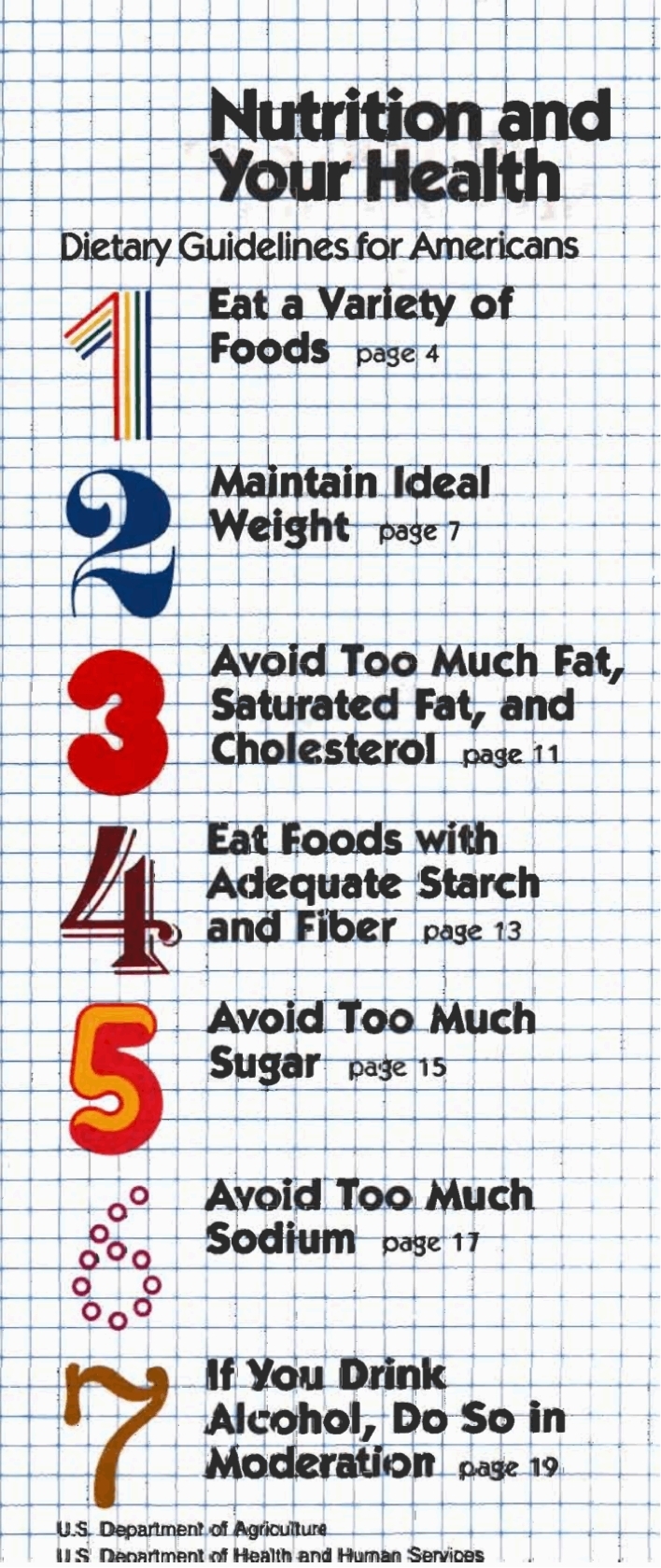
1980 Dietary Guidelines for Americans. Reproduced from reference 29.
1985 DGAs
In general, the second edition of the DGAs was similar to the 1980 edition. Minor wording changes were made to some of the guidelines (Figure 5) (32). Issues related to the prevention of chronic disease were introduced, presumably in response to the growing recognition of the overweight and obesity epidemic. Two years after the 1985 DGA report was issued, the House Committee on Appropriations directed the USDA and HHS to establish a Dietary Guidelines Advisory Group on a periodic basis. The intent was to task this group of scientists with reviewing the scientific data relevant to nutritional guidance and making recommendations to the Secretaries of the USDA and HHS for updating the DGAs.
FIGURE 5.
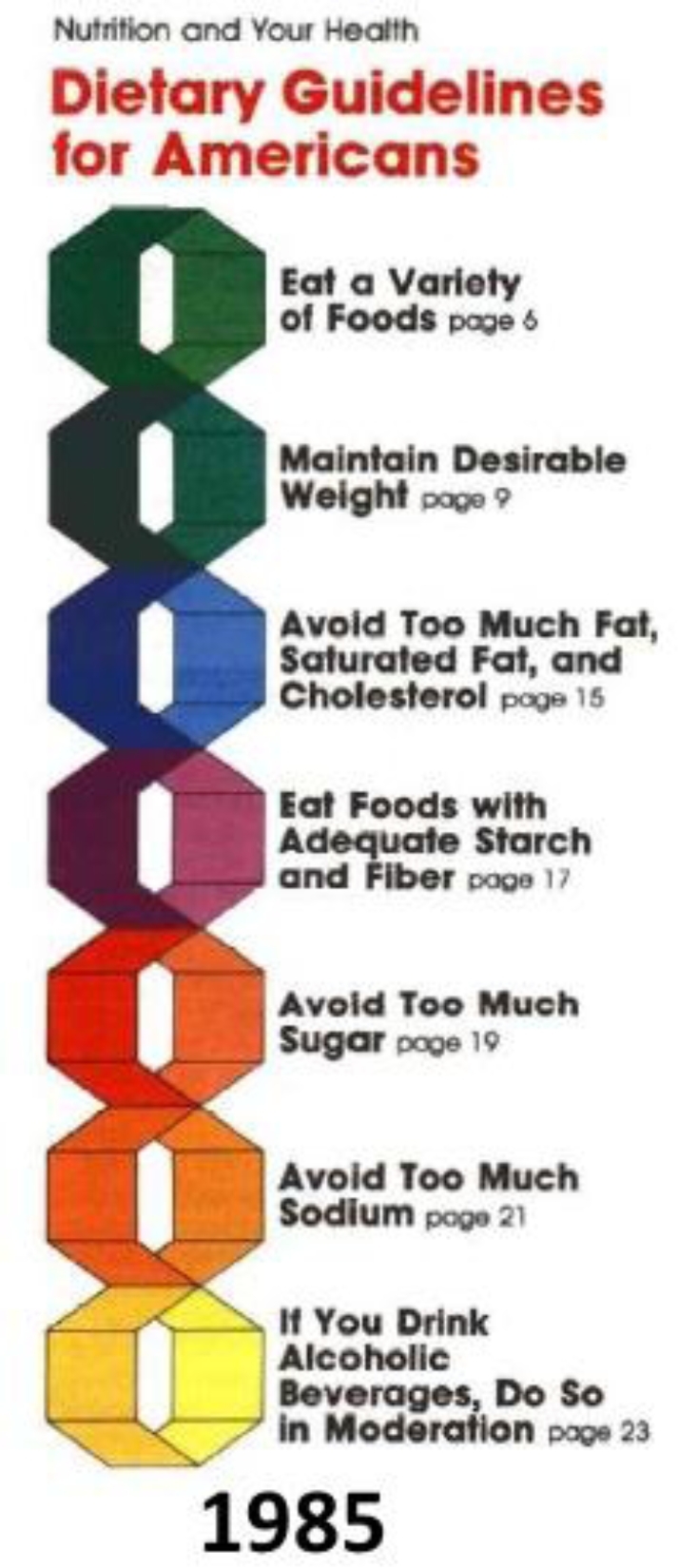
1985 Dietary Guidelines for Americans. Reproduced from reference 32.
Concurrent with this activity to ensure a periodic review and potential update of the DGAs, in 1990 the National Nutrition Monitoring and Related Research Act (Pub L No. 101-445 §301, 7USC 5341, title III 1990) was passed by Congress. The law gave the responsibility for the DGAs jointly to the Secretaries of the USDA and HHS. It directed them to issue, at least every 5 y, a report entitled Dietary Guidelines for Americans, and mandated that the publication contain nutritional and dietary information for the general public, based on the preponderance of scientific and medical knowledge at the time of publication. It was further specified that the role of the committee was to advise the Secretaries of the HHS and USDA, and noted that the 2 departments had the right to review and amend the text before publication. Importantly, it instructed that all federal policy and publications addressing issues related to nutrient and dietary guidance for the general public be consistent with the DGAs.
1990 DGAs
During the period when the legislation was developed, a scientific advisory committee had been convened by the Secretaries of the HHS and USDA. This committee issued the third edition of the DGA report (Figure 6) (6). For the most part, the 1990 DGA report recommendations were similar to the 1985 DGAs. The major change was to reword the guidelines from negative (avoid) to positive (choose) wording. The shift in wording from negative to positive was supplemented with text indicating that the DGAs could be achieved by eating a variety of foods and eating those foods in moderation, rather than dietary restriction. It was emphasized that food could be both enjoyable and healthful. The 1990 DGA report was the first to suggest quantitative goals for fat and saturated fat. Importantly, and sometimes overlooked, it was clearly stated that these quantitative goals should be evaluated over several days, rather than with a single meal or food.
FIGURE 6.
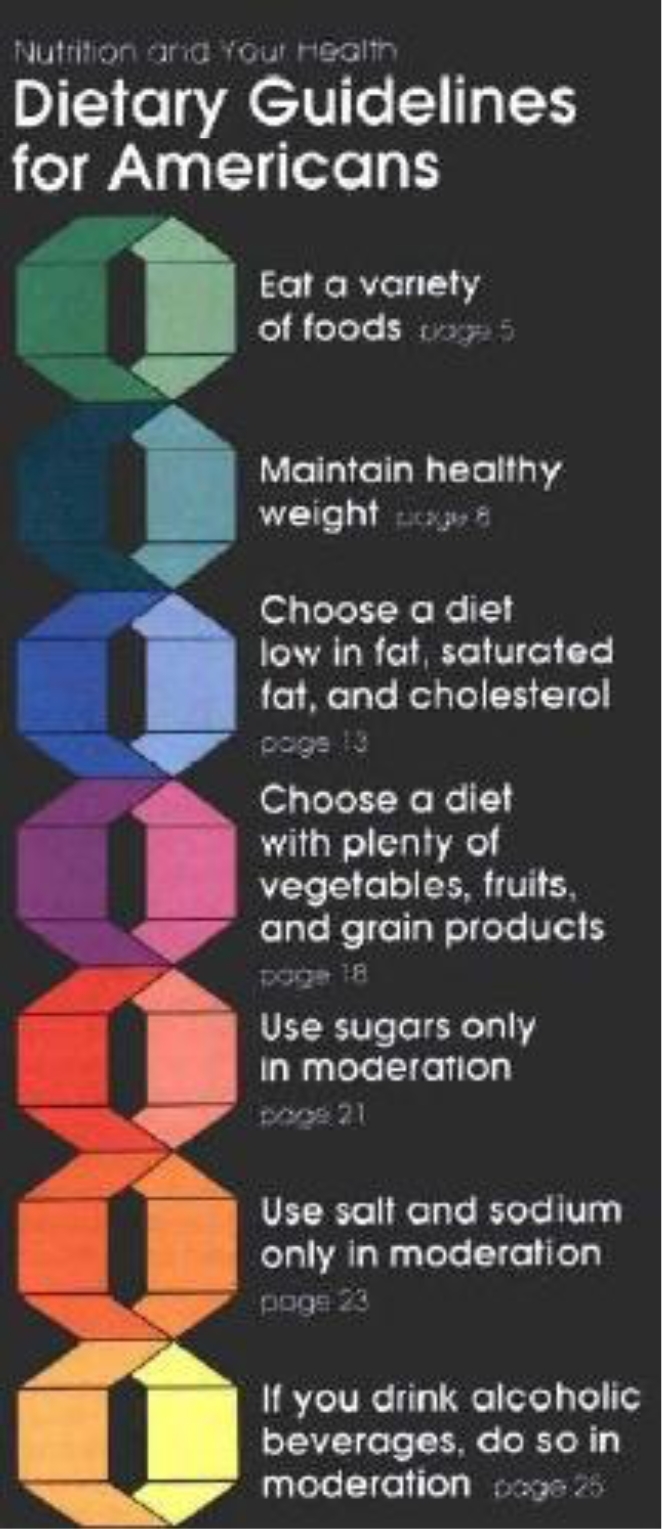
1990 Dietary Guidelines for Americans. Reproduced from reference 6.
1995 DGAs
Whereas the 1980, 1985, and 1990 DGA editions were issued voluntarily by the HHS and the USDA, in 1990 the National Nutrition Monitoring and Related Research Act made issuing the 1995 DGA edition mandatory (Figure 7) (7). Changes included final shifts from negative to positive wording and the inclusion of information linking the DGAs to the Food Guide Pyramid and the Nutrition Facts Panel. The importance of regular physical activity was added to the 1995 DGA report for maintaining a healthy body weight.
FIGURE 7.
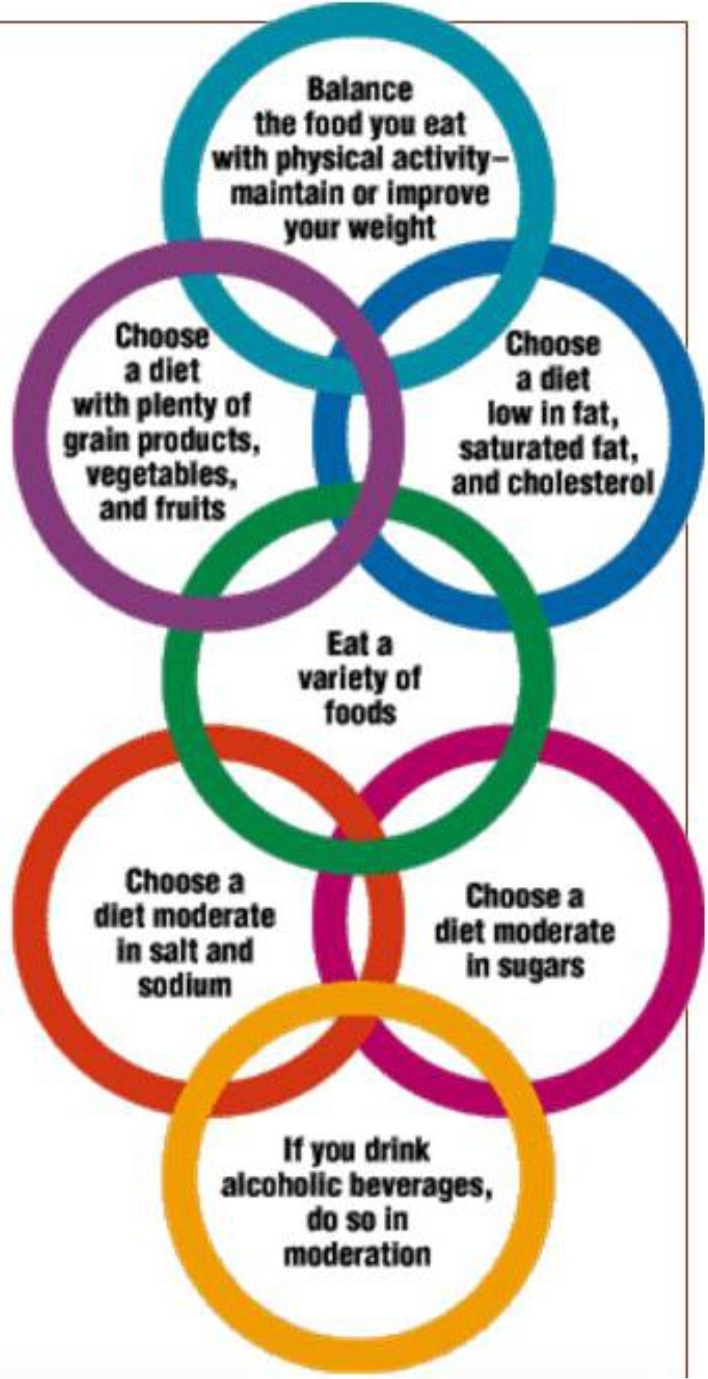
1995 Dietary Guidelines for Americans. Reproduced from reference 7.
2000 DGAs
Although the process used to develop the 2000 DGA report was similar to that used for the 1995 report, significant changes were made to the guidelines themselves (Figure 8) (33). For the first time, the number of guidelines was expanded from the original 7 to 10. Physical activity was separated from body weight to recognize that there are health benefits of regular physical activity independent of energy balance. During the rewording of the DGAs over the years, grains shared the same guideline as fruit and vegetables, encouraging consumption. Because the American public was consuming adequate amounts of grains but not enough fruit and vegetables, these food groups were separated into 2 groups: 1) fruit and vegetables and 2) grains. Furthermore, emphasis was placed on advising the American public to choose ≥50% of their grains as whole grains. Last, a guideline on safe food handling was added.
FIGURE 8.

2000 Dietary Guidelines for Americans. Reproduced from reference 33.
2005 DGAs
The 2005 DGAC adopted a more formalized systematic approach to review the literature than was used previously, defining questions by using the PICO (population, intervention, comparator, outcome) approach. When using the DGAC report to formulate the DGAs, the USDA and the HHS shifted the focus of the DGA document from the general public to policymakers, health care professionals, nutritionists, and nutrition educators (Figure 9) (34). The 2005 DGA report included 9 major dietary guideline messages that resulted in 41 key recommendations, of which 23 were for the general public and 18 were for specific population groups. A companion brochure, “Finding Your Way to a Healthier You,” was issued for the general public.
FIGURE 9.
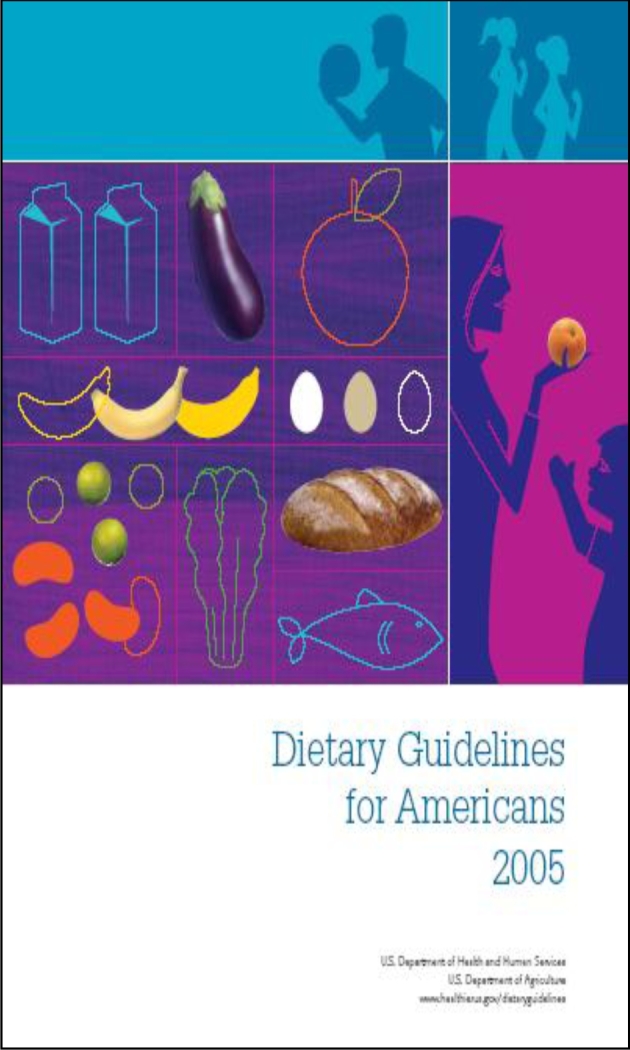
2005 Dietary Guidelines for Americans. Reproduced from reference 34.
2010 DGAs
In 2008, the USDA established the NEL. One of the NEL's functions was to support the DGAC in identifying and reviewing the scientific literature in preparation for writing their report. The overarching theme of the 2010 DGAs was maintaining energy balance over time to achieve and sustain a healthy body weight and consumption of nutrient-dense foods and beverages (Figure 10) (35). The 2010 DGAs included 23 key recommendations for the general population and 6 key recommendations for specific populations. This version of the guidelines introduced the concept of healthy eating patterns, and in 2011 was represented by the MyPlate icon (36).
FIGURE 10.
2010 Dietary Guidelines for Americans. Reproduced from reference 35.
2015 DGAs
The 2015 DGAC used a similar approach in reviewing the literature as the 2010 DGAC. Reflecting most of the DGAC recommendations, the overarching theme of the 2015 DGA report is to focus on the whole diet, emphasizing that there is a wide variety of eating patterns that can result in a healthy diet (Figure 11) (37). The 2015 DGA report includes 5 guidelines accompanied by key recommendations focused on describing elements of healthy eating patterns.
FIGURE 11.
2015 Dietary Guidelines for Americans. Reproduced from reference 37.
Past and future uses of the DGAs
Who uses the DGAs?
The DGAs were originally designed to guide federal nutrition policies, but the uses and users have expanded considerably over time. Currently, the DGAs guide food policies, food assistance programs, and consumer education programs at the federal level, as well as many similar programs at the regional, state, and local levels. Additional users include dietitians and other health professionals, food service personnel, food and beverage manufacturers, and schools and day care facilities. Although the DGA reports are targeted to nutrition professionals, their messages have been translated into many types of consumer materials, as illustrated by the DGA website (38).
How are the DGAs used?
Among the most widely used components of the DGAs are the Healthy Eating Patterns (HEPs). The HEPs for 2015 describe amounts of foods to be consumed daily from 6 major food groups, several of which are further divided into subgroups (37). A seventh food category, “Calories for Other Uses”, specifies a limit on calories, and percentage of calories, from foods that are not included in the major food groups (e.g., fats, sugars, and alcohol). Patterns are presented for 12 calorie intake levels. The HEPs are designed to meet nutrient requirements while not exceeding caloric requirements. For the 2015 DGAs, 3 HEPs were described: US-style, Mediterranean-style, and vegetarian. The HEPs for the 2010 DGAs were very similar to those for 2015, although a Dietary Approaches to Stop Hypertension (DASH) eating plan was described rather than a Mediterranean-style HEP (35). However, the patterns associated with the DGAs before 2010 were somewhat different. For example, the 2005 eating patterns specified different vegetable subgroups and did not include specific recommendations for seafood or for nuts, seeds, and soy products (34).
The HEPs have been particularly useful both for evaluating intakes of population groups and for planning intakes for these groups. For example, the intake data from What We Eat in America, NHANES 2007–2010, were analyzed during the development of the 2015 DGAs in order to identify food group intakes in need of improvement (37). Several figures comparing intakes to recommendations from the HEPs are included in the report. These analyses indicate that Americans need to increase intakes of vegetables, fruit, whole grains, dairy, seafood, and oil and need to decrease intakes of refined grains, added sugars, saturated fats, and sodium.
The HEPs also provide a useful tool for designing menus and making dietary recommendations for population groups. For example, they were the foundation of recommendations in 2006 to change the food packages for the Special Supplemental Nutrition Program for Women, Infants, and Children (WIC), and led to the provision of a cash-value voucher so participants could purchase a variety of fruit and vegetables (39). Recommendations to increase the value of the WIC cash-value voucher were released in 2017, in part to meet the updated DGAs (40). The patterns were also used extensively in an evaluation of the school meals programs and led to several important changes in the content of these meals (41). The school meal recommendations were extended to all ages when the meals and snacks provided by the Child and Adult Care Food Program were revised (42, 43).
To assist in communicating the DGAs and the HEPs to consumers, USDA has developed MyPlate (36), a simplified visual tool that can help consumers plan meals that meet the DGAs. An extensive website is available for use by both consumers and health professionals (36). It includes tip sheets, a daily checklist, and SuperTracker, a consumer-friendly dietary assessment program.
Expanding the reach and uses of the DGAs
All of the DGAs to date have targeted adults and children aged ≥2 y. Although the 1000-kcal diet of the HEPs from the 2010 DGA report has been used to design healthy diets for children 1–2 y of age participating in child care programs (42), this use of the lowest-calorie of the HEPs was not discussed in the corresponding DGA report (37). However, starting in 2020, the targeted ages will expand to include all adults and children. For the first time, infants and children <2 y old will be included in the DGAs. This expansion is an important step forward and will allow more consistency when assessing and planning healthy intakes across childhood. It will be especially helpful for programs such as WIC and the Child and Adult Care Food Program, both of which target infants and young children.
The 2020 DGAs will also include more guidance for pregnant women. Currently, there is limited guidance on healthy diets for pregnant and lactating women in the DGAs. For example, when discussing the importance of calorie balance, the 2015 DGAs suggest that before becoming pregnant, women should achieve and maintain a healthy weight, and women who are pregnant should gain weight within gestational weight gain guidance (37). There is also guidance with regard to seafood choices and amounts for women who are pregnant or breastfeeding. However, the HEPs are not specifically designed to meet some of the unique nutrient needs of pregnant and breastfeeding women. More detailed guidance in the 2020 DGA report will be especially helpful for programs such as WIC.
There are many other possible ways to expand the uses and users of the DGAs in the future. For example, given the widespread education efforts for MyPlate, it would help consumers if the Nutrition Facts Panel on packaged foods specified not only nutrient levels in the food but also the number of servings of the specific MyPlate food groups, such as fruit and vegetables. This knowledge could help consumers choose products with significant amounts of healthy foods, such as fruit (e.g., orange juice), as opposed to those with only token amounts of fruit (e.g., many juice “drinks”).
Another possible way to expand the DGA applications is to better address the use of the HEPs when evaluating (and planning) intakes for population groups. Currently, the HEPs are appropriately designed to help an individual achieve the RDAs for all nutrients (37). However, healthy diets for populations should be designed to minimize the prevalence of intakes that are below the Estimated Average Requirement (44). The Estimated Average Requirement is typically ∼20% lower than the RDA, so it is not clear whether the HEP recommendations should be applied to populations as well as to individuals. More attention to this inconsistency is needed.
Finally, further expansion of the types of HEP would be desirable. As noted above, the 2015 DGA report includes 3 types of healthy patterns, but additional types could be envisioned, particularly to reflect the many cultural eating patterns within the United States. For example, patterns that focus on typical Asian foods or typical Hispanic foods could be widely used as both evaluation tools and educational aids.
The DGAs are a pillar of dietary guidance and have been used in a wide variety of settings and for a wide variety of audiences. They have been used as both evaluation tools and educational aids. Another possibility for expansion is to include more consideration of sustainability when developing dietary guidelines and the HEP. In the future, we can expect the types of uses and users to grow even further, particularly as a result of the expansion of the age groups covered. As the science of nutrition moves forward, future DGAs hold the promise of further improving nutrition policies and programs in the United States.
Conclusions
Dietary guidance in the United States has evolved substantially since Atwater published the first tables of food composition and dietary standards in 1894. The most recent iteration of the DGA report, released in 2015, is the product of >100 y of scientific advancement and streamlined efforts to provide Americans with comprehensive, up-to-date food and nutrition guidance to live a healthy life. Future iterations of the DGAs will include guidance for specific population groups, such as infants and children <2 y old, as well as pregnant women. Transparency in the process will continue to be a key emphasis, as will the role of public comments in informing the DGA. Areas for further expansion of DGA applications should also be considered, such as inclusion of MyPlate food group equivalents on the Nutrition Facts Panel, new methods of applying HEP recommendations to populations, and better representation of cultural diet patterns in the HEPs.
Acknowledgments
All authors read and approved the final manuscript.
Notes
Author disclosures: The authors report no conflicts of interest.
This article is a review from the symposium "History of Nutrition Forum: History of the Dietary Guidelines for Americans" held 25 April 2017 at the ASN Scientific Sessions and Annual Meeting at Experimental Biology 2017 in Chicago, IL.
Supported by the USDA, Agricultural Research Service (3062-51000-051-00D).
Abbreviations used:
- DGAC
Dietary Guidelines Advisory Committee
- DGAs
Dietary Guidelines for Americans
- HEP
Healthy Eating Pattern
- HHS
Department of Health and Human Services
- NEL
Nutrition Evidence Library
- WIC
Special Supplemental Nutrition Program for Women Infants and Children
References
- 1. Atwater WO. Foods: nutritive value and cost. 1894.Historical Dietary Guidance Digital Collection [Internet]. [cited 2017 Dec 2]. Available from: https://nutritionhistory.nal.usda.gov/search/1759574.
- 2. Atwater WO. Principles of nutrition and nutritive value of food. 1901.Historical Dietary Guidance Digital Collection [Internet]. [cited 2017 Dec 2]. Available from: https://nutritionhistory.nal.usda.gov/search/1759178.
- 3. Atwater WO. Principles of nutrition and nutritive value of food. 1910[Internet]. [cited 2017 Dec 2]. Available from: https://archive.org/details/CAT87202134, Accessed Feb 23, 2018.
- 4.101st US Congress. Pub L 101-445, 7USC 5301 et seq, title III 1990[Internet]. [cited 2017 Dec 2]. Available from: https://www.gpo.gov/fdsys/pkg/STATUTE-104/pdf/STATUTE-104-Pg1034.pdf.
- 5. USDA, Center for Nutrition Policy and Promotion Nutrition Evidence Library [Internet]. [cited 2017 Dec 2]. Available from: https://www.cnpp.usda.gov/nutritionevidencelibrary.
- 6. USDA; Department of Health and Human Services. Dietary guidelines for Americans [Internet]. [cited 2017 Dec 2]. Available from: https://health.gov/dietaryguidelines/1990.asp.
- 7. USDA; Department of Health and Human Services. Dietary guidelines for Americans [Internet]. [cited 2017 Dec 2]. Available from: https://health.gov/dietaryguidelines/1995.asp.
- 8. US Bureau of Home Economics Fresh fruits are best in season: with care—they'll keep within reason. 1942. Historical Dietary Guidance Digital Collection [Internet] [cited 2017 Dec 2]. Available from:. https://nutritionhistory.nal.usda.gov/download/1759224/PDF.
- 9. US Bureau of Home Economics Wilt not—waste not: fresh vegetables. 1942.Historical Dietary Guidance Digital Collection [Internet] [cited 2017 Dec 2]. Available from: https://nutritionhistory.nal.usda.gov/download/1759223/PDF.
- 10. National Wartime Food Guide Historical Dietary Guidance Digital Collection [Internet] [cited 2017 Dec 2]. Available from:. https://nutritionhistory.nal.usda.gov/download/1789448/PDF.
- 11. Davis C, Saltos E. Economic Research Service, USDA Dietary recommendations and how they have changed over time. [cited 2018 Feb 23]. Available from: https://www.ers.usda.gov/webdocs/publications/42215/5831_aib750b_1_.pdf.
- 12. Consumer and Food Economics Institute; Agricultural Research Service, USDA Food for fitness: a daily food guide. 1958. Historical Dietary Guidance Digital Collection [Internet] [cited 2017 Dec 2]. Available from: https://nutritionhistory.nal.usda.gov/search/1789418.
- 13. CDC BAM! Body and Mind [Internet]. [cited 2017 Dec 2]. Available from: https://www.cdc.gov/bam/index.html.
- 14. CDC; US Department of Health and Human Services Achievements in public health, 1900–1999: safer and healthier foods. 1999[Internet]. [cited 2017 Dec 2]. Available from: https://www.cdc.gov/mmwr/preview/mmwrhtml/mm4840a1.htm.
- 15. US Bureau of Home Economics Be sure milk and meat are placed in coldest section: this will vary with design of box. 1929. Historical Dietary Guidance Digital Collection [Internet] [cited 2017 Dec 2]. Available from: https://nutritionhistory.nal.usda.gov/search/1759244.
- 16. US Bureau of Home Economics Use enough ice. 1929. Historical Dietary Guidance Digital Collection [Internet] [cited 2017 Dec 2]. Available from: https://nutritionhistory.nal.usda.gov/search/1759248.
- 17. Munsoll HE. Measuring the vitamins. 1933.Historical Dietary Guidance Digital Collection [Internet] [cited 2017 Dec 2]. Available from: https://nutritionhistory.nal.usda.gov/download/1758988/PDF.
- 18. USDA. Foods rich in calcium and phosphorus 1933. Historical Dietary Guidance Digital Collection [Internet] [cited 2017 Dec 2]. Available from: https://nutritionhistory.nal.usda.gov/download/1758966/PDF.
- 19. USDA. Food for Freedom Informational Handbook 1943. Historical Dietary Guidance Digital Collection [Internet] [cited 2017 Dec 2]. Available from: https://nutritionhistory.nal.usda.gov/download/1789419/PDF.
- 20. Sullivan T, Marsh E. Canning through the world wars. In: How did we can? The evolution of home canning practices? [Internet] [cited 2017 Dec 2]. Available from: https://www.nal.usda.gov/exhibits/ipd/canning/exhibits/show/wartime-canning.
- 21. US Bureau of Human Nutrition and Home Economics Fats in wartime meals. 1943. Historical Dietary Guidance Digital Collection [Internet] [cited 2017 Dec 2]. Available from:. https://nutritionhistory.nal.usda.gov/search/1789404.
- 22. US Bureau of Home Economics Fight food waste in the home. 1942. Historical Dietary Guidance Digital Collection [Internet] [cited 2017 Dec 2]. Available from: https://nutritionhistory.nal.usda.gov/search/1789407.
- 23. USDA Eat a good breakfast to start a good day. 1967. Historical Dietary Guidance Digital Collection [Internet] [cited 2017 Dec 2]. Available from: https://nutritionhistory.nal.usda.gov/search/1789395.
- 24. USDA Food guide for older folks. 1962. Historical Dietary Guidance Digital Collection [Internet] [cited 2017 Dec 2]. Available from: https://nutritionhistory.nal.usda.gov/search/CAT40000314.
- 25. USDA A guide to budgeting for the young couple. 1968. Historical Dietary Guidance Digital Collection [Internet] [cited 2017 Dec 2]. Available from: https://nutritionhistory.nal.usda.gov/search/CAT40000493.
- 26. USDA A guide to budgeting for the family. 1976. Historical Dietary Guidance Digital Collection [Internet] [cited 2017 Dec 2]. Available from: https://nutritionhistory.nal.usda.gov/search/CAT87214638.
- 27. USDA Food is more than just something to eat. 1976. Historical Dietary Guidance Digital Collection [Internet] [cited 2017 Dec 2]. Available from: https://nutritionhistory.nal.usda.gov/search/CAT87213550.
- 28. USDA Dietary Goals for the United States [Internet]. [cited 2017 Dec 2]. Available from: https://naldc.nal.usda.gov/naldc/download.xhtml?id=1759572&content=PDF.
- 29. USDA ; Department of Health and Human Services. Dietary guidelines for Americans 1980[Internet]. [cited 2017 Dec 2]. Available from: https://health.gov/dietaryguidelines/1980.asp.
- 30. US Surgeon General Healthy People: the Surgeon General's report on health promotion and disease prevention [Internet] [cited 2017 Dec 2]. Available from: https://profiles.nlm.nih.gov/ps/access/NNBBGK.pdf.
- 31. History of dietary guidance development in the United States and the Dietary Guidelines for Americans: 2015 Dietary Guidelines Advisory Committee Meeting 1: materials and presentations [Internet] [cited 2017 Dec 2]. Available from: https://health.gov/dietaryguidelines/2015-binder/meeting1/historycurrentuse.aspx.
- 32. USDA ; Department of Health and Human Services. Dietary guidelines for Americans 1985. [Internet]. [cited 2017 Dec 2]. Available from: https://health.gov/dietaryguidelines/1985.asp.
- 33. USDA ; Department of Health and Human Services. Dietary guidelines for Americans 2000[Internet]. [cited 2017 Dec 2]. Available from: https://health.gov/dietaryguidelines/2000.asp.
- 34. USDA ; Department of Health and Human Services. Dietary guidelines for Americans 2005[Internet]. [cited 2017 Dec 2]. Available from: https://health.gov/dietaryguidelines/dga2005/document/.
- 35. USDA ; Department of Health and Human Services. Dietary guidelines for Americans 2010[Internet]. [cited 2017 Dec 2]. Available from: https://www.cnpp.usda.gov/dietary-guidelines-2010.
- 36. USDA ChooseMyPlate [Internet]. [cited 2017 Dec 2]. Available from: www.choosemyplate.gov.
- 37. USDA ; Department of Health and Human Services. Dietary guidelines for Americans 2015[Internet]. [cited 2017 Dec 2]. Available from: https://health.gov/dietaryguidelines/2015/.
- 38. Office of Disease Prevention and Health Promotion Tools & resources [Internet]. [cited 2017 Dec 2]. Available from: https://health.gov/DietaryGuidelines/2015/resources.asp.
- 39. Institute of Medicine WIC food packages: time for a change. Washington (DC): National Academies Press; 2006. [Google Scholar]
- 40. Institute of Medicine Review of WIC food packages: improving balance and choice. Washington (DC): ational Academies Press; 2017. [PubMed] [Google Scholar]
- 41. Institute of Medicine School meals: building blocks for healthy children. Washington (DC): National Academies Press; 2009. [Google Scholar]
- 42. Institute of Medicine Child and adult care food programs: aligning dietary guidance for all. Washington (DC): National Academies Press; 2011. [PubMed] [Google Scholar]
- 43. Yaktine AL, Murphy SP. Aligning nutrition assistance programs with the Dietary Guidelines for Americans. Nutr Rev 2013;71:622–30. [DOI] [PubMed] [Google Scholar]
- 44. Institute of Medicine Dietary Reference Intakes: the essential guide to nutrient requirements. Washington (DC): National Academies Press; 2006. [Google Scholar]



